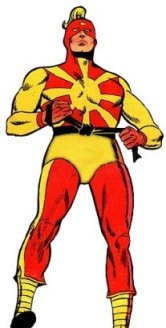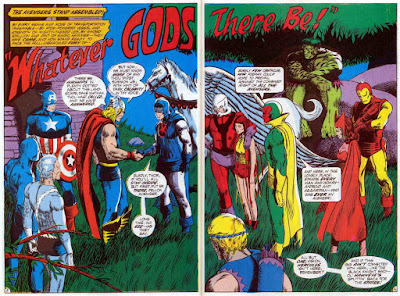Barry (Not-Yet-Windsor) Smith was something of phenom at Marvel when he landed there in the late Sixties. His powerful pencil art became more and more refined, even downright elegant as he developed issue by issue before our very eyes on a number of projects. Of course he's most famous for his Conan work, but he did quite a bit of other super-heroic material for Marvel too.
One of those stints had been a couple of potent issues of Avengers (66 and 67 to be exact), two wild issues which showcased the deadly return of Ultron. Inked by Syd Shores and then George Klein Smith's artwork evoked the power of Kirby, bristling with energy but lacking the subtle storytelling which is hidden in Kirby's deceptive page designs. Smith was replaced by Sal Buscema who debuted as a penciler and made true believers of us all.
Ironically it's Sal who inks Smith when he returns for a three-issue stint on the series several years later in a yarn which sets up the centennial celebration for the venerable comic. Avengers ninety-eight takes place immediately after the epic Kree-Skrull War and the Assemblers are meeting to figure out how to discover the fate of Clint (Goliath) Barton who has been missing since he boarded a Skrull space ship armed with a planet-killing atomic weapon. The device never made it to Earth so they know he completed his mission but his fate remains a mystery. As they split up to find clues a mysterious rabble-rouser named Warhawk whips up racist sentiment in the middle of NYC creating a riot. The Avengers seek to intercede but fall victim to the hatred themselves.
And he's brought along another former Avenger, the mighty Hercules who comes mouthing an enigmatic poem which portends a threat not only to Earth, but to Asgard as well.
In the very next issue, ninety-nine to be exact under another powerful John Buscema cover, Roy Thomas, Barry Smith and new inker Tom Sutton tell us more about Hawkeye's recent past and about Hercules himself.
What they learn is that the tough as nails Clint Barton had boarded the Skrull ship and used his wits and liberated parts to cobble together a bow and arrows outfit which enabled him to destroy the ship and escape in a shuttle. He crash lands on Earth, Yugoslavia in fact where he is helped by a traveling carnival show. In this show he meets a man named "Hercules" who in fact turns out to actually be Hercules, found by the carnies in Greece. He is suffering amnesia and Hawkeye uses the resources of Stark Industries to get him and Herc back to the United States just in time to help out in the battle in NYC against Aries. Just then two Titans named Kratos and Bia appear to kidnap Hercules and after a furious battle with the Assemblers do just that.
There is some question about the Vision's bravery when he elects to protect a fallen Wanda as opposed to helping save Hercules. Nonetheless the Avengers vow to follow and rescue their comrade.
But first they must take a moment to assemble for the one hundredth time as the centennial issue of the comic lands on the stands. Barry Smith is back in the saddle one last time inking himself but needing the help of both Joe Sinnott and Syd Shores to wrap it up. Smith also handles the cover, his first for the series. Roy the Boy's script crams a lot into a small space and this is one comic which I wish had been double-sized, the story sure warranted it.
It begins in England where the Black Knight has summoned the help of the Avengers. They slowly appear and by the time it's finished everyone who has ever been an Avenger in the hundred-issue run is accounted for save for Hercules. Even the Hulk and regular villain Swordsman show up to complete the set.
Thanks to the ghostly apparition of the original Black Knight they learn that Aries had come into possession of the Ebony Blade, thought destroyed by the modern Knight some issues before during a fracas with Arkon and the Enchantress. As the blade appeared on Olympus so did the Enchantress who teams with Aries to use the power of the blade to extinquish a magical flame which gives life to the pure Olympians turning them all to crystal. Only demi-gods remain and they take over Olympus under the rule of Aries. Hercules is beaten and literally thrown from Mount Olympus taking days to fall causing his memory to fail. Now Aries seeks a way to Asgard to vanguish it and sought to create war on Earth as a way to get there. The Avengers divide into to two teams, one to invade Olympus and save Hercules and confront Aries and the other to go to the heart of London and fend off the invading demi-gods who find Earth through a deadly portal to Olympus. The battle is ferocious and at times somewhat funny. The Hulk for instance is bemused by the music of some Satyrs and sits down beside them before snagging the escaping Enchantress. Iron Man is shot down and spends the fight recovering. Cap, Hawkeye, Scarlet Witch, and others fight in the streets of London. Finally the Ebony Blade is recovered by the Black Knight and Aries is defeated. The demi-gods rush back to Olympus as the Avengers leave. Then Thor and Hercules use their might to seal the portal as the Avengers take stock of their immediate victory.
These are some wildly entertaining stories, but it's evident that Barry Smith has lost his interest in superheroes. His style which was still blossoming on the adventures of the Cimmerian has become almost too delicate for the rough and tumble of the antics of the Marvel Universe. His storytelling is pretty keen, but his lithe figures seem out of place in the potent and kinetic world defined by Jack Kirby and redefined by John Buscema. He was a better fit on the Doctor Strange revival in Marvel Premiere but he'd not last long there either. He left Conan the Barbarian and Marvel briefly and returned to work exclusively on Conan. He'd eventually go on to a fantastic career away from mainstream comics.
And that concludes our look (for this year at least) at the Kree-Skrull War, its origins, events and aftermath. Maybe we'll get around to more of this in the future, and as Criswell so masterfully put it, the future is where we will spend the rest of our lives.
See Ya!
Rip Off
















Note that the comic wasn't double-sized, but it was 23 pages during a time when stories only ran 20 or 21. But I agree, a few more pages for ish 100 would have been awesome!
ReplyDeleteStrange fact: I found #100 about a month after I got ish 101. Lucked up and found it tucked behind some magazines (not on the usual spinner rack) at the local King Kwik. Man, was Young Groove ever happy!
And is it just me, or do Tom Sutton's inks over BWS look just plain far-out?
I've long been a Sutton inks booster. His inks on Smith were especially sweet on the few Conans they did together. He brings an edge, where Buscema is lush and lovely, Sutton gets depth in his lines. This epic story had three issues, one penciler, one writer, two cover artists, and four five inkers. Avengers assemble indeed.
DeleteRip Off
I remember my friends and I really being amazed by Smith's art on these; the question of how appropriate it was to the material was not even a question. The portrayal of Hulk sitting off to one side in the shadows and the later scene of him enjoying pastoral music had to have been Smith's contributions. That final issue with the ethereal inking felt mythic and oneiric, like the Avengers had wandered into a Midsummer Night's Dream. If you step back and notice a knight on a winged horse, legendary gods and demons, the look is not inappropriate. Your recent coverage of the Zodiac gang makes me wonder what eerie imagery Smith then, or Windsor-Smith now, might find in them.
ReplyDeleteI really like that comparison of the Avengers entering A Midsummer Night's Dream, that really does evoke the feeling one gets from this story. It weird and lyrical and elegant. Not what one expects from a Marvel story from this period and certainly a hallmark of what Windsor-Smith was to become.
DeleteRip Off